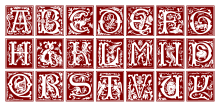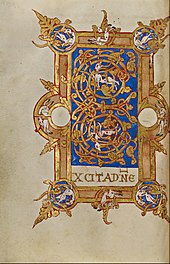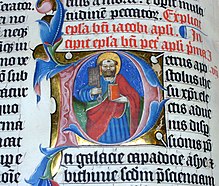Initial
In a written or published work, an initial[a] is a letter at the beginning of a word, a chapter, or a paragraph that is larger than the rest of the text. The word is derived from the Latin initialis, which means standing at the beginning. An initial is often several lines in height and in older books or manuscripts are known as "inhabited" initials. Certain important initials, such as the Beatus initial or "B" of Beatus vir... at the opening of Psalm 1 at the start of a vulgate Latin. These specific initials in an illuminated manuscript were also called initiums.
In the present, the word "initial" commonly refers to the first letter of any word or name, the latter normally
History

The
In the very early history of
-
Greek biblical text from Papyrus 46, of c. 200, with no initials, punctuation, and barely spaces between words
-
5th century Codex Alexandrinus with initials in left margin
-
Leaf from a Coptic manuscript, 6th-14th century, Metropolitan museum of Art, New-York
-
"Diminuendo" effect in the first letters after this initial from the Cathach of St. Columba (Irish, 7th century)
-
One of thousands of smaller decorated initials from the Book of Kells
-
In principio from the start of the Gospel of John, 9th century
-
IlluminatedGeorgian letter "D" from the Mokvi Gospels
-
Large initial L from a Romanesque Bible
-
Opening from the Mainz Psalter, printed in 1457, with small printed and large drawn initials.
-
Fraktur
-
Alexander Agricola's score: "Fortem virili"
-
Two row-wide P initial, followed by small capitals
Since 2003, the W3C is working for initial letter modules for CSS Inline Layout Module Level 3, which standardized the output of initial letters for web pages.[1][2]
Types of initial
The initials are
The initial may sit on the same baseline as the first line of text, at the same margin, as it does here. This is the easiest to typeset on a computer, including in HTML. An example follows (using Lorem ipsum nonsense text):
Lorem ipsum dolor sit amet, consectetur adipisicing elit, sed do eiusmod tempor incididunt ut labore et dolore magna aliqua. Ut enim ad minim veniam, quis nostrud exercitation ullamco laboris nisi ut aliquip ex ea commodo consequat. Duis aute irure dolor in reprehenderit in voluptate velit esse cillum dolore eu fugiat nulla pariatur. Excepteur sint occaecat cupidatat non proident, sunt in culpa qui officia deserunt mollit anim id est laborum.
Alternatively, the initial may be in the left margin, with the text indented, as shown here. In word processors and HTML, this may be implemented using a table with two cells, one for the initial and one for the rest of the text. The difference between this and a true drop cap may be seen when the text extends below the initial. For example:
L orem ipsum dolor sit amet, consectetur adipisicing elit, sed do eiusmod tempor incididunt ut labore et dolore magna aliqua. Ut enim ad minim veniam, quis nostrud exercitation ullamco laboris nisi ut aliquip ex ea commodo consequat. Duis aute irure dolor in reprehenderit in voluptate velit esse cillum dolore eu fugiat nulla pariatur. Excepteur sint occaecat cupidatat non proident, sunt in culpa qui officia deserunt mollit anim id est laborum.
With a drop cap, the initial sits within the margins and runs several lines deep into the paragraph, indenting some normal-sized text in these lines. This keeps the left and top margins of the paragraph flush.
In modern computer browsers, this may be achieved with a combination of HTML and
Lorem ipsum dolor sit amet, consectetur adipisicing elit, sed do eiusmod tempor incididunt ut labore et dolore magna aliqua. Ut enim ad minim veniam, quis nostrud exercitation ullamco laboris nisi ut aliquip ex ea commodo consequat. Duis aute irure dolor in reprehenderit in voluptate velit esse cillum dolore eu fugiat nulla pariatur. Excepteur sint occaecat cupidatat non proident, sunt in culpa qui officia deserunt mollit anim id est laborum.
In some older manuscripts, the first letter of normal sized text after a drop cap also would be capitalized, as may be seen in the Mainz Psalter above, and in the original 1609 printing of Shakespeare's sonnets. This evoked the handwritten "diminuendo" style of gradually reducing the text size over the course of the first line. This style now is rare, except in newspapers.
Inhabited initial

An inhabited initial is an initial, an enlarged letter at the beginning of a paragraph or other section of text that contains an illustration of human or animal figures within the letter. It is similar to a historiated initial (see below); however, the figures in historiated initials show an identifiable scene or story, while the figures in inhabited initials do not show a narrative.[4] Figures in inhabited initials may be related to the contents of the text, but do not have to be. They may be purely decorative instead.[5]
Historiated initial

A historiated initial is an initial, an enlarged letter at the beginning of a paragraph or other section of text, that contains a picture. Strictly speaking, a historiated initial depicts an identifiable figure or a specific scene, while an inhabited initial (see above) contains figures (human or animal) that are decorative only, without forming a subject. Both sorts became very common and elaborate in luxury illuminated manuscripts. These illustrated initials were first seen in the Insular art of the early 8th century. The earliest known example is in the Saint Petersburg Bede, an Insular manuscript of 731–46, and the Vespasian Psalter has another.[6]
The size and decoration of the initial further gives clues to both its importance and location. Letters that began a new section of a text or a particularly noteworthy section might receive more flourishes and space. They would also provide a visual point of reference, "marking the division of the text into books, chapters, paragraphs and sometimes even verses" since, due to the cost of parchment, the modern convention that a new section will begin on a new page had not emerged.[7] In luxury manuscripts an entire page might be devoted to a historiated initial.[8]
Both the size and the ostentatiousness of a manuscript reflect both on the status of the manuscript and on its owner. Manuscripts meant for everyday use, typically by friars or university students, often had little illumination, and hardly any elaborate historiated initials or flourishes. Manuscripts commissioned by wealthy patrons or for a wealthy monastery were often illuminated, and in gold or silver rather than pen and ink.
See also
- Calligraphy – Visual art related to writing
- Insular script – Medieval writing system common to Ireland and England
- Insular illumination – style of manuscript illumination originating in the British Isles and Ireland
- Letras y figuras
- List of Irish manuscripts
- Lombardic capitals – Type of decorative capital letter
- Middle initial– Abbreviation of middle name
- Miniature (illuminated manuscript) – Picture in an ancient or medieval illuminated manuscript
- Monogram – Motif made by overlapping two or more letters
- Typography – Art of arranging type
Notes
- ^ Also referred to as a drop capital (or drop cap or drop), initial capital (or initial cap, initcapital, initcap or init), or titling capital.
References
- ^ Dave Cramer; Elika J. Etemad; Steve Zilles (8 August 2018). "CSS Inline Layout Module Level 3". W3C Working Draft. World Wide Web Consortium. Retrieved 29 January 2019.
- ^ Marcotte, Ethan (17 June 2019). "Drop caps & design systems". Vox Product Blog. Vox Media. Retrieved 25 June 2019.
- ^ "Inhabited Initial E". Getty Museum. Retrieved 29 January 2022.
- ^ "Glossaries: I". Catalogue of Illuminated Manuscripts. The British Library. Retrieved 27 November 2017.
- ISBN 0-19-860476-9.
- ^ Brown 2007, p. 10.
- ^ MacDonald, Elizabeth (10 January 2019). "Lighting the Way: How Illuminated Initials Guided Medieval Readers through Books". Europeana Blog. Retrieved 14 January 2019.
- ^ Clemens & Graham 2007, p. 29.
Further reading
- Stiebner, Erhardt D; Urban, Dieter (1985), Initials and Decorative Alphabets, Poole, ISBN 0-7137-1640-1.
External links
- Typolis.de
- Types of illuminated initials in the Glossary of Medieval Art and Architecture
- Ornamento Ornamento contains close to a quarter of a million ornate letters, ornaments, borders, musical notation, diagrams, and illustrations drawn from Iberian print before 1701.
- Initials and Ornaments by Book Historian on Flickr.com
- Alphabets & Letters at Reusableart.com
- Make the letter bigger: A history of initials at ilovetypography.com
- 35 historiated initials from the Huntington Library
- Historiated Initial from the "Song of Songs"
- "Making of Illuminated Manuscripts" from the Encyclopedia of Irish and World Art
- "Decoration and Illumination" from Manuscript Studies: Medieval and Early Modern
- 100,000 printed initials (1470–1700) at Flickr.com











